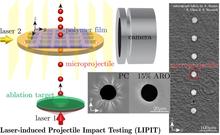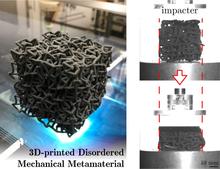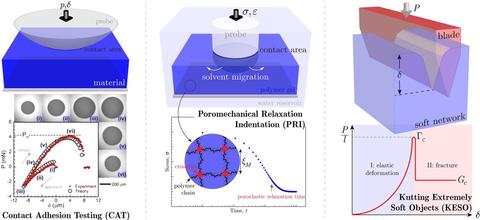Summary
Polymers play a central role in high rate impact mitigation applications ranging from helmets, to body armor, to aircraft and spacecraft protective coatings. A myriad of energy dissipating mechanisms are available in impact mitigating materials as they consist of a hierarchy of material elements working together. The dominant energy dissipation mechanism depends on the materials system and impact scenario, which is not well understood.
We are developing new measurements to study polymeric materials from the individual element level up to the system level to establish the relationships between polymer structure and physics that underpin the mechanical performance of engineered structures, composite interfaces, thin films and membranes. By coupling the results from these measurements with theory, simulation, and modeling, we will facilitate computational design of energy mitigating materials with partners from the Materials Genome Initiative (MGI).
Description
The mechanical behavior for polymers is very sensitive to the deformation rate of the impact test. Thus we are developing and applying several novel measurements that can study the mechanical response of the polymer at different deformation rates and at different material length scales.

High-rate Energy Dissipation of Polymer Films

In collaboration with Dr. Stephan Stranick (Materials Measurement Science Division), we have constructed a Laser-induced Projectile Impact Testing (LIPIT) instrument to study the impact and puncture penetration of a microparticle onto a polymer film at impact velocities ranging from 10 m/s to 1 km/s. By measuring the kinetic energy loss due to puncture of the microparticle, we can quantify the puncture energy of the polymer film at such extremely high deformation rates (~105 s-1 to 107 s-1).

Impact Mitigation of Disordered Networks
We are part of the Center for Hierarchical Materials Design (CHiMaD) Impact Mitigation Use Case with the goal of combining computational modeling and state-of-art experiments to design next generation impacting mitigating materials. Specifically, we are working with Profs. Heinrich Jaeger, Sid Nagel and Juan de Pablo from the University of Chicago to study the medium rate (~100 to 102 s-1) impact behavior of disordered mechanical metamaterial that was designed via a pruning algorithm that can tailor the elastic constants of the metamaterial. In collaboration with Dr. Aaron Forster and Dr. Michael Riley (Materials Measurement Science Division), we are measuring the stress transfer of these materials via instrumented drop tower testing to quantify the mechanical impedance of these metamaterials as a function of deformation rates.
Adhesion & Fracture of Gels & Soft Networks
We are also studying the adhesion, elasticity and fracture properties of gels and soft networks such as hydrogels, biopolymer gels and bottlebrush networks at quasi-static deformation rates. To measure the properties of these materials, we use nontraditional contact mechanics-based measurements including Contact Adhesion Testing (CAT), Poromechanical Relaxation Indentation (PRI), and Kutting Extremely Soft Objects (KESO).

NIST Center for Neutron Research
Our research on the mechanics of polymers and interfaces heavily leverages the neutron scattering facilities at the NIST Center for Neutron Research (NCNR). We use Small-angle Neutron Scattering (SANS) and Quasi-elastic Neutron Scattering (QENS) to study the structure and dynamics of materials, respectively. SANS characterizes the structure (i.e. spatial correlations) of the polymer material, such as persistence length or mesh size, that is directly related to elasticity. QENS provides information about the dynamics (i.e. dynamic correlations) within the material, such as segmental motions, that is relevant to its fracture toughness.
Customers & Collaborators

Postdoctoral Research Opportunities
National Research Council (NRC) Research Associates Program (RAP)
RO#: 50.64.21.B8564 - High Rate Mechanical Properties of Materials
RO#: 50.64.21.B8284 - Model Polymer Gels and Networks for Rational Membrane Design
RO#: 50.64.21.B7643 - Polymer Membranes for Water Purification

